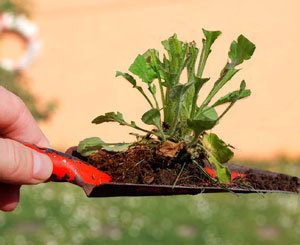Bird netting
Protect your plants from prey by draping bird netting over grapevines, fruit trees and even vegetables.
• Build a flat canopy over the entire area using round steel poles with wire across the top to hold up the netting.
• Drape the netting over the framework, pull it tight and secure it at the base, ensuring the netting is drawn tightly so birds and other animals won’t become entangled.
• Good-quality netting can last up to 10–15 years and the frames 50–60 years with very little maintenance except in severe storms or hail, which may cause minor damage.
Cool climate: Use framework to raise netting over fruit trees, pull tight to remove any sag, then tie it down to the base of the trunk.
Temperate: Inspect netting for signs of tearing caused by prey or branch movement during high winds.
Tropical: Inspect trees for new growth. Thin out some branches or raise the bird netting so the branches won’t becoming entangled in the netting.
Watering
Use bottomless pots around new plants to help direct water to their roots, enabling water levels to remain constant for longer.
• Dig a hole to a depth of 300–400mm where the seedling is going to be planted.
• Place the seedling in the hole and cover the root ball with soil.
• Place the bottomless pot over the plant and in the ground, then compact the soil around the pot to the rim.
• Apply a small amount of organic compost inside the pot, making sure it is not in direct contact with the seedling. Then water with one litre of diluted Seasol.
• Use this method to help retain the moisture around the plant.
Cool climate: Water once a week during spring, then twice a week in summer.
Temperate: Water once a week with an application of Seasol every two weeks to help strengthen the root system.
Tropical: Water plants twice a week in the early mornings to avoid the heat of the day boiling the water.
Compost
Making your own compost is the foundation for establishing a long-lasting and successful garden.
• Choose a spot in the garden where excess moisture from the compost is able to drain away into the soil.
• Start with a layer of soil at the base then add some green organics such as grass and weeds, add a layer of kitchen scraps, then top it with shredded paper or cardboard and cover over with some more composted soil.
• Allow it to start breaking down over the next 2–3 weeks, occasionally turning it over with a garden fork.
Cool climate: Keep the compost covered using old carpet or a lid to help keep the heat in while the micro bacteria do their work breaking down the scraps.
Temperate: Inspect your compost regularly, add water if it seems too dry or add soil if it seems too wet.
Tropical: Remove the cover and ensure the compost isn’t heating too fast and cover when rains are predicted to avoid too much moisture build-up.
Snails
• Rather than use toxic snail pellets, sprinkle broken egg shells or place coconut coir around the base of the plants.
• Alternatively, create a barrier by using chicken mesh around the plants. The holes in the mesh are too small for the snails to get through and crawling over it is virtually impossible for them.
Cool climate: Check your garden for snails early in the morning; be sure to check the hidden sides of your pots, too.
Temperate: After early-morning rains, the snails will be on the crawl for a good feed. Find them, pick them and feed them to your chooks.
Tropical: Baby snails on the leaves mean families below. You’ll find them hiding below the foliage close to the roots of the plants where it’s cool. Pick them and squash them.
Worm farm
As the weather heats up, so will your worm farm. Keep an eye on it.
Cool climate: Drain the worm juice regularly and inspect the casting to make sure it’s not too wet. Too much moisture will kill your worms.
Temperate: Position your worm farm in a shaded area away from direct sunlight to avoid any sudden rise in temperature that would cause the farm to heat up too quickly.
Tropical: If hot weather is forecast, remove the lid and place a few layers of wet newspaper or carpet over the top to help keep the compost cool. Drain the worm juice regularly to prevent the worms from boiling during the hot summer days.
Tomatoes
Summer is salad time and only homegrown tomatoes will do.
Cool climate: Grow the best crop of tomatoes by training only two leaders to grow up side by side on each plant. Remove any additional side shoots that develop to avoid too much foliage growth.
Temperate: As the tomatoes ripen, pick the fruit and remove all the foliage surrounding them. This will also provide better air circulation and help to promote strong sap flow to the top of the plant where it’s needed the most.
Tropical: Watch out for rust and mildew developing. This is caused by excessive heat and humidity. Spray bluestone on a weekly basis to control the spread of these viruses, but be careful not to spray the flowers to avoid loss of fruit.




